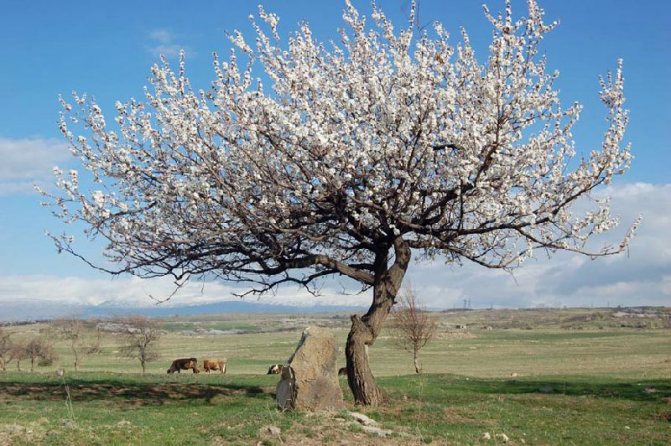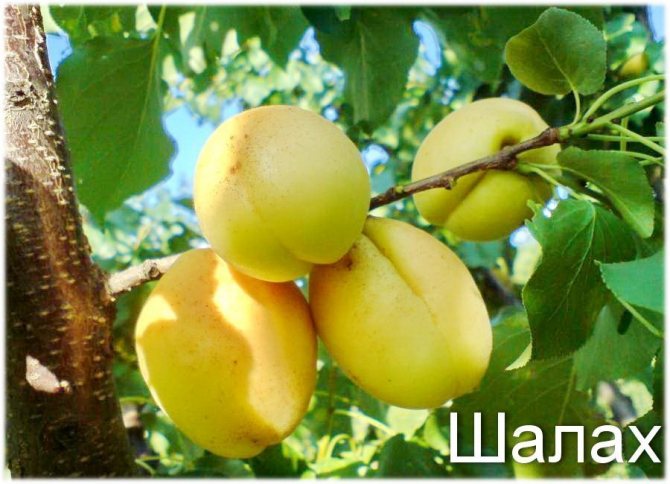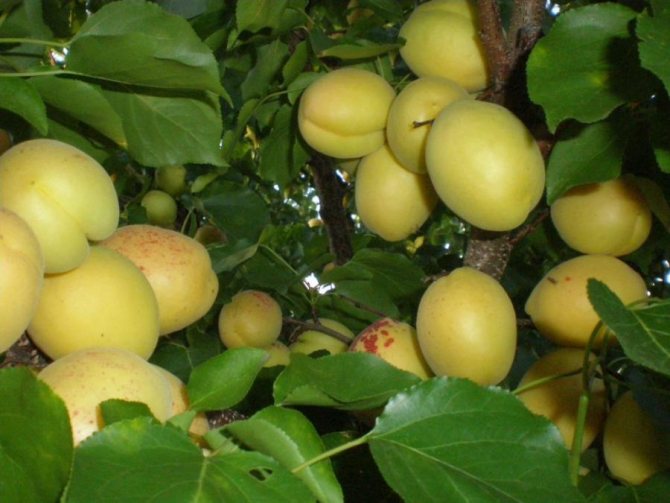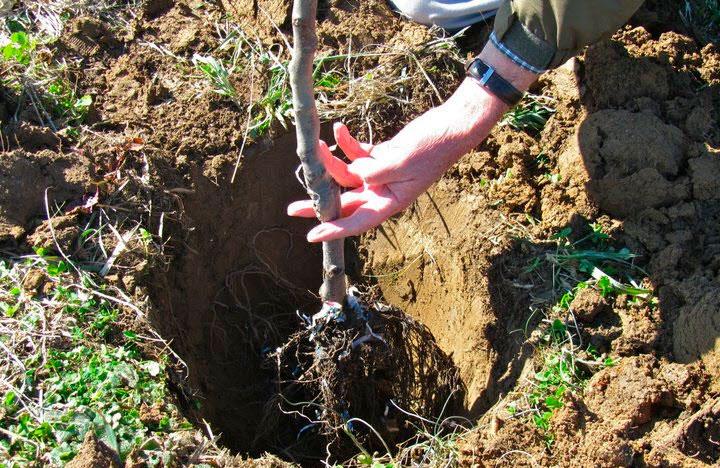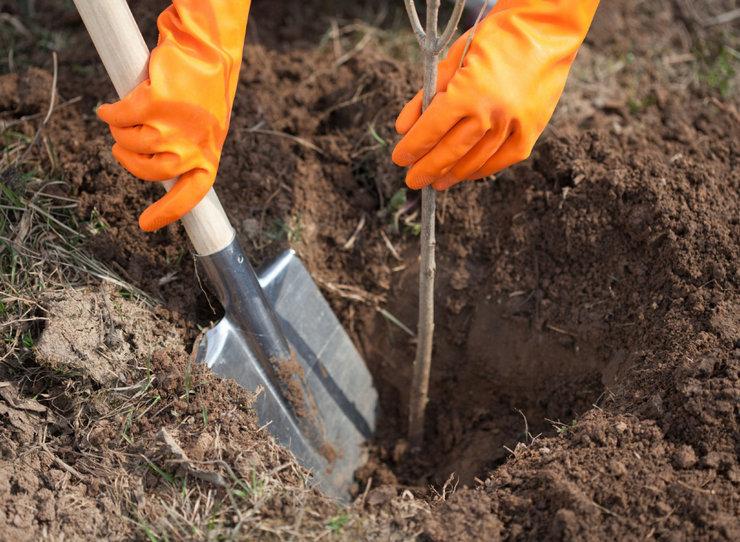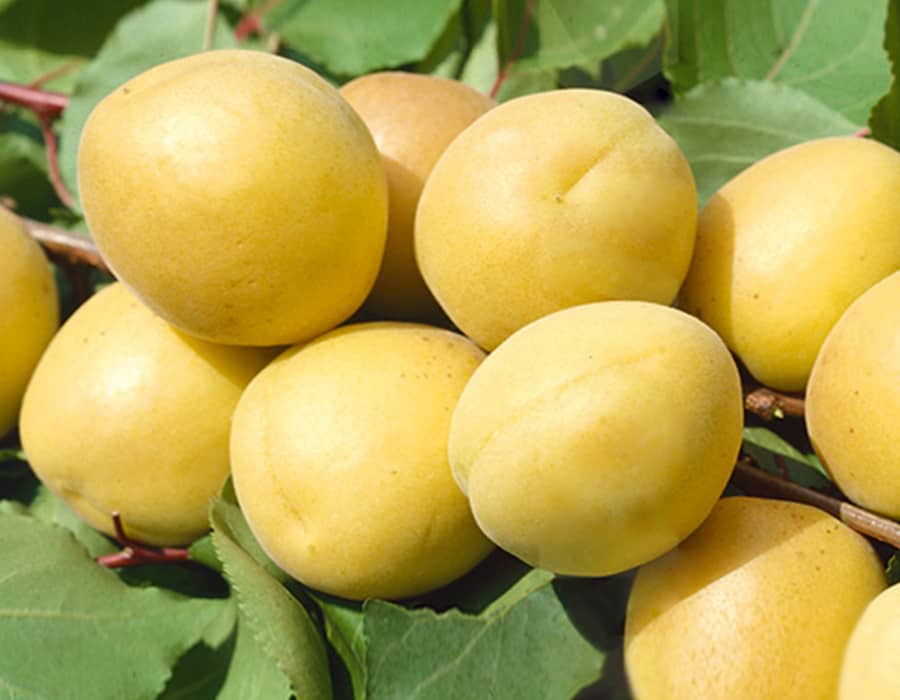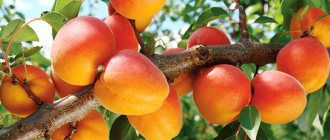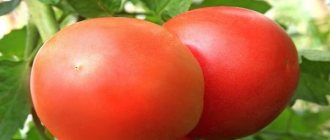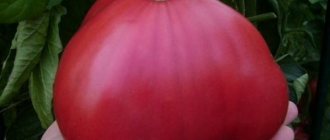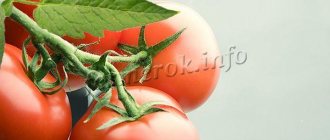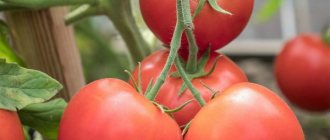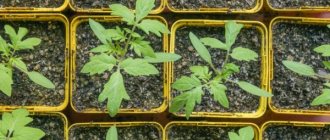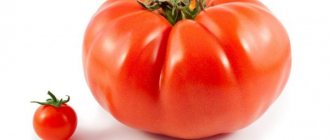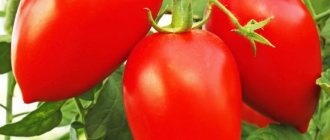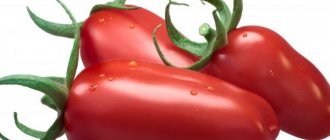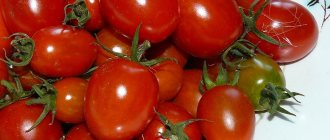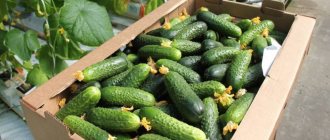.
Apricot Shalakh is one of the unique varieties with excellent taste. Its other name is pineapple apricot. It enjoys wide popularity: it is grown not only in our country. The fruit is hardy and adapts to different climatic conditions.
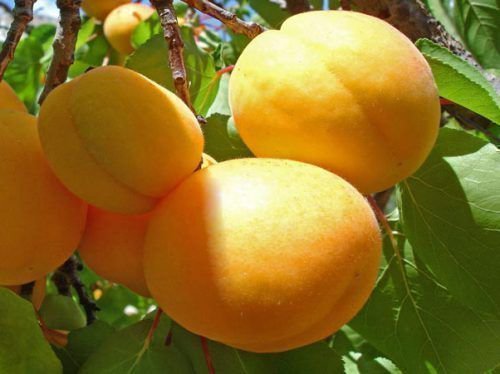
Apricot Shalakh is also called "pineapple"
Some gardeners call this variety differently - Yerevan apricot. The second name is associated with the place of its appearance: it was in Armenia that these white juicy sweet apricots were bred by local breeders. They can be eaten fresh, canned, and in salads, added to baked goods and desserts.
Pineapple is a fragrant variety of juicy apricots. Description, features of planting and caring for a tree
Apricot Shalakh was bred in Armenia, first appeared in the Nikitsky Botanical Garden at the beginning of the 20th century. Recommended for breeding in warm areas. Medium-sized trees with broad, rounded but not dense stands. Shoots are large, curved, thick. Inflorescences are large, cream color with a light pinkish tint. Leaves are heart-shaped, emerald tone.
Apricots are large in size, weighing about 50 grams. Their color is yellow, with a reddish blush and orange flesh. The taste is slightly sour, but more sweet and quite aromatic.
From 1 tree, 100-200 kg of fruits are harvested. If you take good care of the apricot, you can get 350-400 kg of fruit. The ripening period is early, the harvest is harvested at the end of June. Trees can withstand frosts down to -25 degrees, it is undesirable to grow them in Siberia and other areas with frosty winters. Resistance to fungal infections is high.
In favorable conditions, there is no difficulty in growing the Shalakh variety. Caring for a tree is not difficult, but it requires systematicity and regularity.
Soil care
The first time after planting (1–1.5 months) watering should be abundant and regular: 2 approaches per week. If the weather is rainy, then once is enough. A bucket of water is poured onto each tree.
The volume depends on the point of occurrence of the groundwater, as well as on the type of soil and the age of the plant. When watering, the soil should be saturated by 30–35 cm.
Important! In July, the amount of moisture is reduced, since an excess of moisture during this period provokes a prolonged growth of shoots, which reduces the cold resistance of the culture.
After moistening, the trunk circle is shallowly loosened, and weeds are also removed.
Mulching the soil is important for young trees. They do this every year for winter and summer to protect the roots from cold and drought. Lay a layer of mulch tightly, 7-10 cm thick.
Top dressing
If the land was prepared correctly during planting, then they begin to feed the crop only after the first harvest has been taken.
Experts recommend using the following fertilizers:
- Compost, humus. Introduce every 3-4 years during autumn or spring digging of the site. The norm is 5–7 kg per 1 m².
- Organic food. They are brought in every summer, after the formation of ovaries, with an interval of 15–20 days. Just 2-3 times is enough. The norm is 10 liters per 1 m². Preparation of the mixture: 2 liters of mullein are poured with a bucket of water and insisted for 6-7 days. The infusion is diluted in water (1:10) and used as fertilizer. If there are no ovaries, then there is no need for such fertilizer.
- Ammonium nitrate, urea or nitroammofosk. It is added to the soil every spring. Consumption: 20-30 g per 1 m².
- Potassium monophosphate or sulfate. Used in the formation of ovaries and fruit development. The preparations are diluted with water and the soil is moistened at the rate of 10–20 g per 1 m².
- Superphosphate. Add to the soil during autumn digging. The norm is 30–40 g per 1 m².
- Complex feeding. Make according to the instructions.
Pruning
Competent crown formation increases crop yield, prevents diseases, and also increases sugar content and fruit weight. Also, the tool is disinfected before trimming, and the cut sites are treated with garden varnish.
Pruning is carried out according to the following rules:
- When landing. The branches are shortened by 1/3, and the vertical processes are removed. This stimulates the growth of lateral shoots and forms a bowl-shaped crown.
- When growth is inhibited. The branches are pruned, leaving them up to two years old.
- Thinning stripping. It is performed annually, in the spring, until the buds open.
- Full cropping. It is carried out to the very base of the shoots. Do not leave hemp.
- With excessive overgrowth. Young shoots are shortened by 10-15 cm so that they thicken and have time to prepare for the cold. The procedure is performed in August.
- Removing branches dropping to the ground. Performed as needed, as well as to prevent decay and disease.
- Sanitary pruning. Remove old, ineffective, twisted shoots. Performed in late autumn or early spring.
- Annual crown formation. Perform for maximum illumination. Collect vertically growing shoots.
Preparing for winter
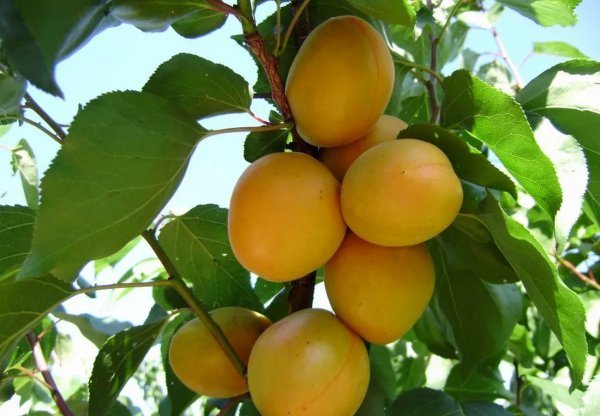

Despite the fact that Pineapple Apricot can withstand frost, it still needs some protection.
A young tree can be wrapped whole, from the ground to the top. Natural and synthetic materials can serve as insulation:
- polyethylene or polypropylene film;
- plastic of various types;
- agrofiber;
- straw;
- fabric for bags;
- stalks of sunflower and corn.
Humanity has been cultivating apricots for a very long time. The seeds of this tree, found in Armenia, date back to around 3000 BC.
All the past time, people have been trying to improve the characteristics of the plant to suit their needs. Specialists in different countries are working on the development of new varieties and hybrids.
Our scientists continue to work on this problem. One of the varieties worthy of attention is Pineapple.
Description of the variety
Apricot tree Pineapple, 4–5 m high, has a spreading and wide crown with many branches and an abundance of foliage. The gray bark has sinuous longitudinal cracks. The leaves are bright green, dull, rather large. The color of flowers is dominated by white, and only at the base is a pinkish tinge noticeable.
Fruits of medium and large size 30-50 g (weight depends on growing conditions) round in shape. The skin is thin, velvety, yellow in color, sometimes with a dotted reddish blush. The pulp is medium-dense, juicy, creamy. The fruit taste is sweet, without sugary, with a slight sourness and a characteristic pineapple aroma. The stone is small, well separated.
Apricot Pineapple (another name - Shalakh) is a variety of Armenian selection, but many argue that it was bred in the Crimea in the State Nikitsky Botanical Garden. However, for gardeners, this is not of fundamental importance.
Due to its positive qualities, Pineapple is used for breeding new varieties. One of them is the Pineapple Tsyurupinsky variety, obtained by selecting seedlings in the gardens of the Kherson region.
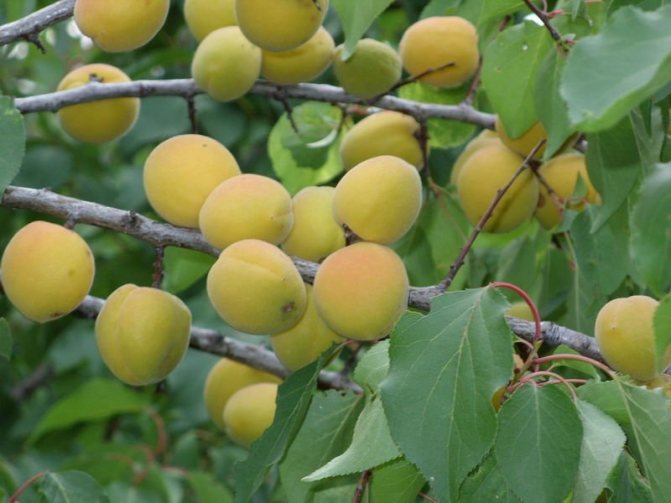

Along with the improvement of some properties (for example, increased resistance to diseases), Tsyurupinsky is in many ways inferior to his "father": the fruits are smaller and crumble heavily, their quality is greatly influenced by the surrounding conditions, the yield is lower, and the productive period is about 25 years.
The height of the Pineapple columnar tree does not exceed 2.5 m. Due to the compactness of the crown, the apricot can be grown in a tub. Abundant ovaries form right on the main trunk.
The columnar variety can be grown even in a tub
An important point when growing any tree is the choice of planting material. Planting Pineapple apricot is no exception.It is advisable to purchase a one-year seedling 60–70 cm high, which already has 2–3 branches. The bark of the tree should not have wounds, cracks or any other damage.
The root system is branched and fibrous with 2-3 taproots. The presence of thorns on the trunk indicates the semi-wild origin of the plant - it is better to refuse this. The safest way is to purchase a tree in a nearby nursery: it will be more adapted to local conditions.
It is better to buy seedlings in the nursery.
Planting apricots is recommended in the spring. Over the summer, the seedling will get stronger and be able to successfully endure the cold.
Seat selection
Apricot Pineapple is a light and heat-loving plant, so when choosing a planting site, you need to take into account that shading will negatively affect its growth.
It does not tolerate an apricot of excessive moisture - it should not be planted in a lowland, a small hill will be much better (the variety does not suffer from the wind). He is not picky about the composition of the soil.
Of course, chernozems or loams would be the best option, but this is not of fundamental importance, the main thing is that there is no increased acidity.
The apricot needs to be planted in a bright, elevated place.
Planting an apricot
The landing pit is prepared in the fall. Its size depends on the size of the root system, but you need to focus on the diameter and depth of 0.7 m.Pour two buckets of any organic fertilizers into the hole and leave until spring for the soil to shrink. If the soil is too dense, then a bucket of coarse sand can be added to the organic matter.
The pit is being prepared in the fall
Before planting, which is carried out before the start of sap flow, once again you need to inspect the roots, remove the damaged ones. If they have dried out a little, then put the seedling in a solution of some root-forming agent for 2 hours (this will improve survival rate).
The root collar must be above the soil level
When landing, you should follow a simple sequence.
- Pour 0.3 kg of superphosphate, 0.1 kg of potassium sulfate and 1 kg of lime or dolomite flour into the prepared pit, mix with organic matter (on poor soils, add another 0.1–0.2 kg of urea).
- Drive in a peg to support the seedling.
- Set the plant, straighten the roots and fill the hole halfway with earth (make sure that the grafting site is 5-10 cm above the soil level), compact it a little with your palm.
- Pour out a bucket of water.
- Top up the soil to the desired level.
- Pour out the second bucket of water.
Apricot Pineapple is an unpretentious plant and does not require much attention to itself. To keep the tree in good condition, only the most necessary work is carried out.
Pruning
Of the minimum work required, trimming is the most important. Pineapple grows quickly and has a lot of shoots, so it shouldn't be overlooked.
You need to prune the tree twice - in spring and autumn. When planting, in order to obtain a correctly formed crown, the central conductor is cut out to branch with branches that need to be shortened by a third.
In the second or third year, the central conductor is constantly shortened, stimulating the growth of the lateral branches. 3-4 skeletal branches are left on the trunk and 3-4 semi-skeletal branches on them. All the extra ones are cut into the ring.
Thus, a bowl-shaped crown is formed, ideally suited to light-loving apricots. In the future, it is necessary to constantly monitor the number of branches. All intertwining, growing inward, thickening shoots must be removed.
In order to avoid contamination of the plant with viral diseases, it is necessary to disinfect the working tool and process the sections with garden pitch.
Planting a seedling
This planting method is more common. For autumn planting, a pit is prepared at the end of summer, and for planting in spring - in September or October. The size of the pit is 70 by 70 by 70 cm.The bottom is covered with branches and gravel with a layer of 20 cm.
Trees need neutral soil, so the soil should contain humus, superphosphate, a little potassium salt, 1 kg of wood ash and 1 kg of lime. Having mixed all these components, you need to pour them into the pit with a slide, and then insert the seedling there.
The root system must be leveled manually, separating each root from each other, and then cover the hole with earth. The soil should be compressed and immediately water the seedling with at least 20 liters of water. Around the trunk, you can put some peat or sawdust in a layer of 15 cm. It will warm the roots and fertilize them at the same time.
Relatives
Apricot Shalakh was used by breeders to develop new species, Pineapple Tsyurupinsky and Pineapple Columnar. They were obtained by the method of selection of seedlings in gardens in the Kherson region.
Apricot Pineapple Tsyurupinsky is inferior to the Shalakh variety. He has small fruits, they crumble strongly, their quality is strongly influenced by the environment. The yield is lower, the productive period lasts 25 years.
The trees grow up to 2.5 meters in height. Due to the shallow bushes, apricots can be grown in a tub. Ovaries are formed directly on the base trunk.
Main advantages
When describing the Shalakh variety, one cannot fail to mention the advantages of the plant, thanks to which it enjoys more and more popularity:
- Resistance to diseases and pests inherent in fruit trees.
- Bountiful harvest. Therefore, Shalakh apricots are often grown on an industrial scale.
- Fruits' resistance to transportation.
- The ability to store them for a long time in refrigerated chambers while preserving all the properties of apricots.
- One of the most effective ways to breed Shalakh is grafting. Compared to many fruits, this apricot will not die when combined with other varieties and types of fruit trees: plum, cherry plum, peach. It will take several years for the process to take root and begin to grow.
- Usually begins to bear fruit 3-4 years after planting. Most varieties of apricot trees yield only 5–6 years of age.
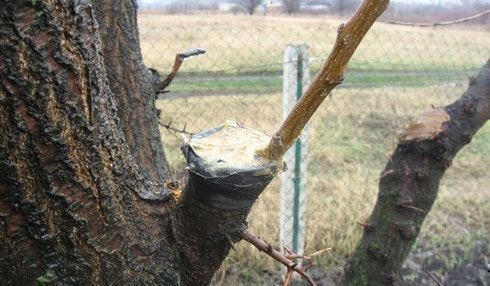

Apricot Shalah can be grafted onto different types of fruit trees
What are the advantages and disadvantages of the variety?
Description of the variety
Apricot Shalah has many benefits. There are also negative sides, but they are few.
| pros | Minuses |
| Increased resistance to diseases, harmful beetles | Tendency to thicken the bushes |
| Abundant fruiting | Rapid shedding during fruit ripening |
| Possibility of long-term transportation, long-term storage in the refrigerator | |
| Early maturity | |
| Presentation of fruits, large sizes | |
| Increased resistance to cold |
This variety was created in the Crimea, its "small homeland" - the State Nikitsky Botanical Garden. Not listed in the State Register of the Russian Federation. The tree has good (but not absolute) immunity against moniliosis and clotterosporium, worse, but also well resists curly leaves. The apricot turned out to be quite drought and cold tolerant (down to -25 ° C).
The height of the tree for an apricot is average - 3.5–4 m. Branches grow quickly, so the crown is prone to thickening. The plant needs regular pruning. Flowering rather late (second decade of May). This reduces the risk of flowers and ovaries getting caught in return frosts.
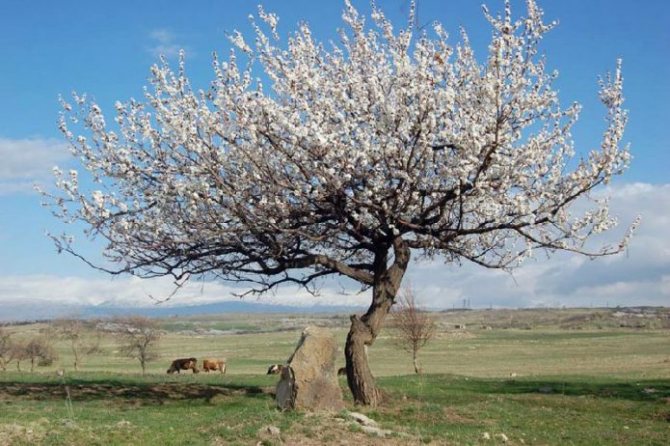

Apricot Pineapple is distinguished by a high growth rate of shoots - as a result, the crown quickly thickens
The apricot is fast-growing (the first harvest is expected for 3-4 years). Annual fruiting from the 4th to 5th year. In optimal climatic conditions and with quality care, 130–150 kg are obtained from an adult tree. In the Urals and Siberia, 45-50 kg can be removed. But the yield is highly dependent on the weather in spring and summer - the more the apricot receives light and heat, the more fruit you will harvest.
Ripe apricots quickly crumble from the branches, you cannot hesitate in harvesting. The quality of overripe fruits deteriorates sharply - they turn into mealy and almost tasteless.It is easy to understand whether the fruit is ripe - they have a special smell typical for the variety. Harvesting at the stage of technical ripeness is not worth it - the fruits will become a little juicier, but not sweeter and more aromatic.
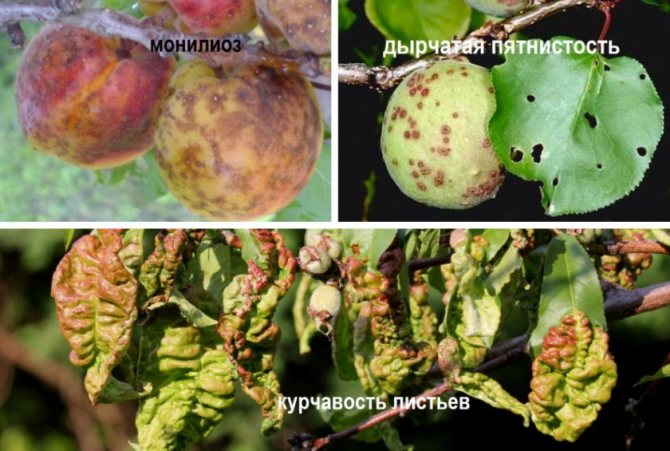

Pineapple is a mid-season apricot, fruit picking in the south falls on the 15-25th of July, in a temperate climate you will have to wait another 7-10 days. They are oblong in shape, slightly flattened from the sides, slightly bumpy to the touch. Weight - 35-50 g. For an apricot, this is very good.
Description of fruits
The skin is pale yellow, matte, rough, almost without edges. It is soft and thin, almost unnoticeable when eating. The “blush” characteristic of most varieties of apricot is almost absent, manifesting itself in the form of blurred light pink spots.
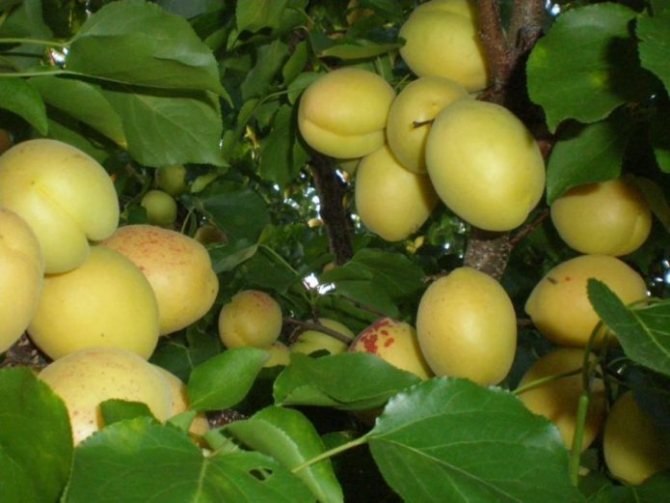

Pineapple, these apricots resemble not only the characteristic taste and aroma, but also the color of the skin
The pulp is brighter than the skin, almost orange next to the stone. It is very juicy, sweet, not particularly dense, with almost imperceptible fibers. There is a pronounced pineapple aroma and flavor, which is why the variety got its name.
Check out these articles as well
- Strawberry variety Albion
- Raspberry variety Patricia
- What can you give to rabbits?
- How to treat diarrhea in calves
There are a lot of positive qualities of the Shalakh apricot variety, and all of them, one way or another, affected the popularity of the species in different regions.


The yield can reach 150 kg
- The yield can reach 150 kg, but only in warm latitudes, the cooler the climate, the less fruit the tree gives.
- The first fruiting occurs 3-4 years after planting, a similar early maturity to the liking of most gardeners.
- Frost-hardy, winters usually endure without significant problems, but only in warm regions, such as the Crimean peninsula. If the frost "touched" the tree, it quickly recovers after that.
- There is resistance to clasterosporium and moniliosis.
- Due to the density of apricots, they are easy to transport over long distances. The commercial qualities after harvest and over the next 6-8 days are excellent.
- Suitable for cultivation in small private areas and for industrial purposes.
Now about the disadvantages.
- Since the Shalakh apricot is an early one, late spring frosts can damage flowers or flower stalks and lead to reduced yields.
- The yield depends on the climatic conditions.
- When overripe, the fruits fall off the branches.
Fruit characteristics
The fruits of the Armenian Shalakh apricots are very large: one fruit weighs about 90 g. They are oblong in shape: oval or ovoid. The abdominal suture is thin, but clearly defined. There are small bumps on the peel. The peel can vary in color: from pale pink with a yellow tint to creamy with a raspberry blush on the sides. Outwardly, Shalakh is similar to the Dobele apricot.
Pineapple apricot has a matte surface, not glossy like many other varieties. Its peel is dense, slightly velvety. The pulp of the fruit has a pronounced taste: very sweet with notes of sourness. The pulp is of medium density, not mealy. The stone is small, easily separated from ripe fruit. When the fruit is overripe, coarse fibers appear in it. Another important characteristic: the fruits of these trees appear every year and in large quantities.
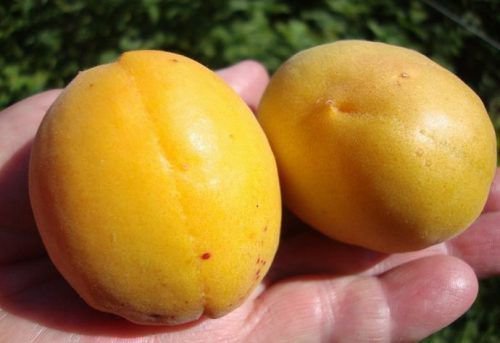

Apricot Shalakh bears very large fruits
Ripening and harvesting
Armenian apricots of the Shalakh variety ripen in early July, the exact dates depend on the weather conditions. Fruit is picked by hand only, especially if it is intended to be eaten fresh or stored. If you shake the branches, they easily crumble, injuring when hitting the ground. It is best to do this on a dry, fine day, but you should not wait on purpose. You need to have time to harvest in 5-7 days so that overripe fruits do not crumble - they break off the stalk very easily.
Fresh fruits are put in wooden or cardboard boxes, the air temperature is gradually lowered in order to keep them longer. Slightly mashed fruits are best sent for processing. They make wonderful desserts, and even jams, jams, dried, dried apricots can delight with aroma, taste, healing qualities all winter. In order to keep fresh fruits longer, they are harvested until fully ripe, transferred with napkins, and stored at a low air temperature.
Bone planting
The stone is taken from large, ripe and healthy fruits. Before planting, it is placed in warm water for a day so that the kernel swells and can germinate faster. After that, the seed can be planted in good soil, saturated with trace elements. An area protected from the winds should be chosen. The depth of the hole is 5–6 cm. If you dig a bigger hole, the seed will germinate for a long time, that is, the outer waters will slowly reach it. The distance between the holes should be up to 15 cm so that the bones do not interfere with each other during the development process.
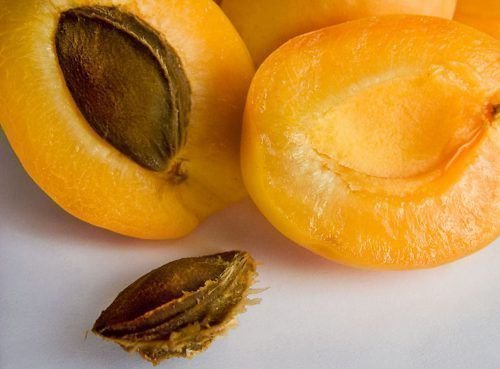

For planting, you should take a stone from a ripe apricot
After planting, the pit is covered with dry grass so that the seedling does not freeze when the air temperature drops. Apricots usually begin to sprout in the spring. Two years later, when the sprout is formed, the tree must be transplanted to a permanent habitat, choosing it taking into account the characteristics of the variety.
Diseases and pests
The Shalakh apricot variety is practically not exposed to insect attacks and diseases. In the absence of proper care, the presence of damage to the cortex, gum leakage is possible.
Every 2 months, the apricot tree is treated with antifungal compounds, insecticides. Plants are sprayed in dry weather when there are no winds.
- Plum aphid. The insect destroys young foliage, it shrivels, withers. If a problem is found, the trees are sprayed with insecticides like Fitoverm, Bitoxybacillin, respectively, annotations to them. As a preventive measure, in spring and autumn, they dig up the near-trunk circle, prevent the appearance of ant nests under the tree. The plum moth is destroyed in the same way.
- Yellow plum sawfly. It affects the seeds, pulp, damaged apricots do not develop. Prevention includes whitewashing with lime with the addition of copper sulphate, the installation of hunting belts. They will destroy the beetle with insecticides.
- Leaf roll. The caterpillar destroys the buds, does not allow the fruit to develop, and affects the foliage. Eliminate it in the same way as the above beetles.
Provided that preventive manipulations are performed, the apricot tree will not hurt.
The Pineapple variety is resistant to clasterosporium disease and curly leaves, but apricot can attack other diseases.
Care
One of the mandatory procedures for caring for an apricot is pruning; it is carried out annually in spring and autumn. Until the age of four, the formation of the crown is necessarily carried out, during the same period, cutting off the flowers will help strengthen the apricot.
An important role is also played by the regular removal of weeds, loosening, this will help to keep the trunk space clean. Maintaining the required moisture level will also ensure the optimal ripening rate of the fruit after natural leaf fall.
Top dressing of a tree depends on the condition of the soil. In the spring, nitrogenous compounds are introduced, at other times phosphorus-potassium fertilizers are used. If it is necessary to constantly fertilize the tree, organic chemistry is introduced into the trunk circle.
Whitewashing of the trunk is also considered one of the care procedures. A layer of lime will help get rid of the pests lurking in the cracks, and it will also help prevent tree burns.
In the spring, it is recommended to dilute the mixture with 2 tbsp. copper and iron vitriol, the consistency of 5 liters of lime should resemble liquid sour cream. The procedure promotes the healing of frostbites, prevents pests from climbing to the top of the trunk.
Pros and cons of the variety
According to the description, the benefits of Pineapple apricot outweigh its disadvantages. A self-fertile, early-ripening variety with excellent resistance to some common diseases, drought and frost, which regularly gives a large number of large, tasty, healthy fruits of almost white color, cannot but attract. The fruits of universal use are well transported, which is convenient for those who grow Pineapple apricots for sale.
The disadvantages include shedding of fruits after ripening and a short shelf life. Ripe fruits can be stored at a low temperature for up to 10 days. If you try very hard (collect at the stage of technical maturity, wrap it up separately with paper), then this period can be extended to 3 weeks.
- Those who have practiced the cultivation of Shalakh note the following positive characteristics:
- fairly stable fruiting;
- large fruits;
- good productivity;
- peculiar aroma and taste of apricots;
- good transportability;
- quick recovery of the tree after frost;
- self-fertility;
- tolerance of short-term moisture deficit;
- good frost resistance;
- immunity to many specific diseases.
- Among the disadvantages, gardeners note:
- short storage period for fruits (no more than two weeks);
- predisposition to thickening;
- shedding of fruits in case of overripe.
The origin of the apricot
The initial habitat of the plant is the Tien Shan mountains. The Chinese were the first to domesticate the apricot - more than 4 thousand years ago. Through Central Asia and the Persian Empire, the golden fruits reached the Mediterranean, where they were received with enthusiasm. The Romans gave the apricot its current name, which translates as “treasure”. After all, the apricot ripens earlier than other garden fruits.
Ancient Russia also knew apricots, but only in dried form. In the 17th century, two apricot trees appeared in the garden of Tsar Alexei Mikhailovich. Boyars and monks tried to plant apricots in their domains. But these attempts most often ended in failure. The flower buds of a southern tree do not withstand cold weather. They die already in the middle of winter. Young trees do not withstand frost. For a long time, only semi-cultivated apricot varieties with small sour fruits grew in Russia.
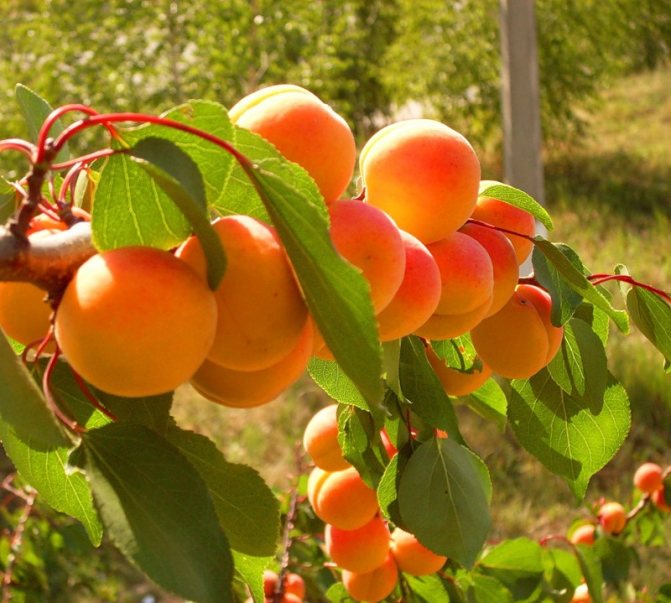

Apricot "Red-cheeked" is disease-resistant
Description of the plant
The apricot tree grows up to 8 m. The dense crown is formed by many branches. Leaves in different varieties can be in the form of an oval, circle, heart, but in all cases they have a sharp tip.
The tree blooms in March-April, with large single flowers of white and pink color. Apricot is a close relative of peach and rose. Therefore, its flowers are very beautiful and fragrant.
The fleshy fruits of the tree ripen in August. The weight of each fruit is 3-18 g. The color of the fruit depends on the variety of apricots. The photos represent different shades of ripe fruits:
- white;
- pale yellow;
- bright yellow;
- Orange:
- orange red;
- red;
- the black.
The fruit contains one hard bone. The kernel of the stone in many varieties of apricots is edible.
The closest "relatives" of the plant are peaches and plums. Botanists consider almonds, raspberries, olives, coffee and mangoes to be "cousins".
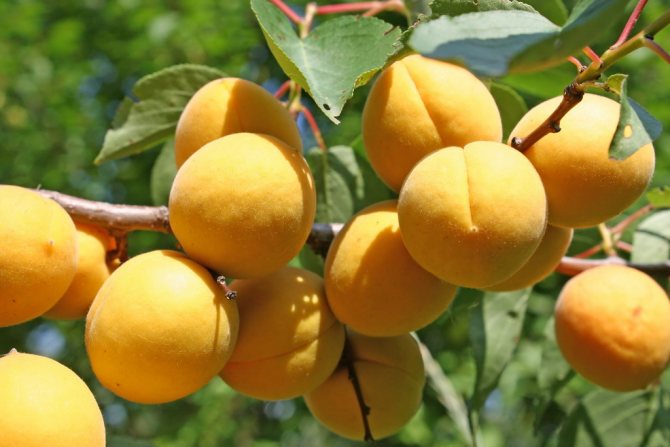

Apricot "Triumph of the North" bears large orange fruits with sweet pulp
Black apricot
Gardeners who are fond of unusual varieties will not disregard a hybrid of cherry plum and apricot. Similar trees originated in Central Asia and Transcaucasia due to spontaneous crossing of fruit trees of two different species. For a long time it was believed that the black apricot could not grow in the conditions of Central Russia.
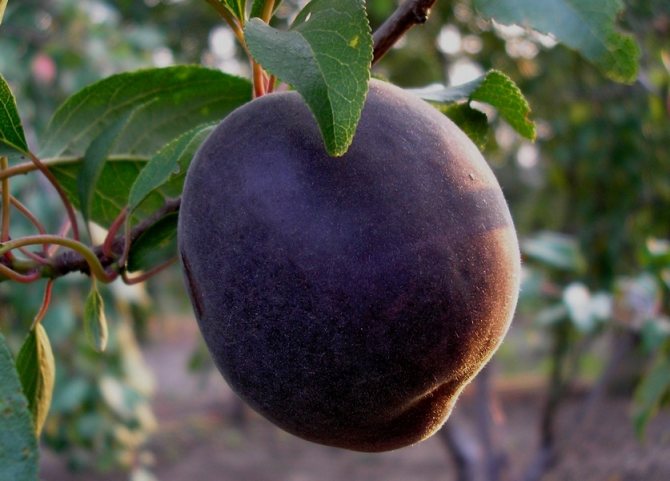

Apricot black velvet gives good yields of small sweet fruits
Michurin made the first experiments with a tree, and he managed to bring out the first specimens wintering in Russia.Frost-resistant hybrids of black apricot were developed by multiple crosses with common apricot, plum, blackthorn, cherry plum. As a result, several new varieties were eaten:
- "Mouse". A variety of apricot that successfully survives in the Moscow region. The photo represents dwarf trees with small sweet and sour fruits. They grow and bear fruit even indoors, in tubs;
- "Black Velvet". A winter-hardy tree, but requires shelter in harsh winters. Gives good yields of small sweet fruits;
- "Kuban black". Fruiting less often than conventional varieties. It bears small sweet fruits with a slight sourness. It can withstand a mild winter, but flower buds and young branches suffer in severe frosts.
New varieties of black apricot can be planted in the Moscow region. Caring for them is the same as for conventional frost-resistant varieties.
Apricot properties
It is no coincidence that nature has provided apricot with a seductive taste and smell for human receptors. There are many useful components in sweet fruits:
- pectin;
- dextrin;
- inulin;
- fruit acids;
- vitamin C;
- provitamin A;
- potassium;
- silicon;
- sodium.
Apricots strengthen the immune system, especially in the elderly, pregnant women, children. They make up for iron deficiency in anemia. Eating fresh and dried fruits improves health for diseases such as:
- heart failure;
- hypertension;
- stomach diseases;
- nervous stress;
- hidden edema.
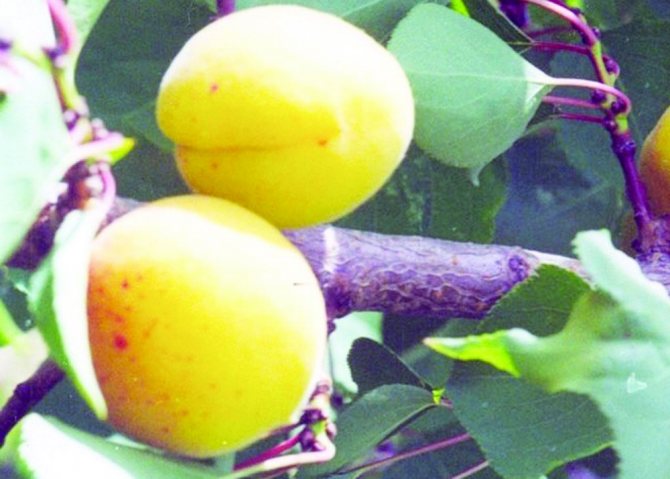

Apricot Honey bred in the cold Ural climate
Since the beginning of the 20th century, the healing and taste qualities of fruits have prompted breeders to work on the development of cold-resistant varieties available to Russians.

